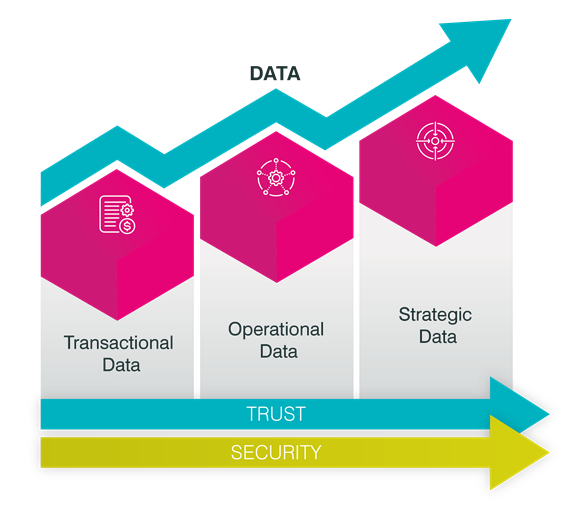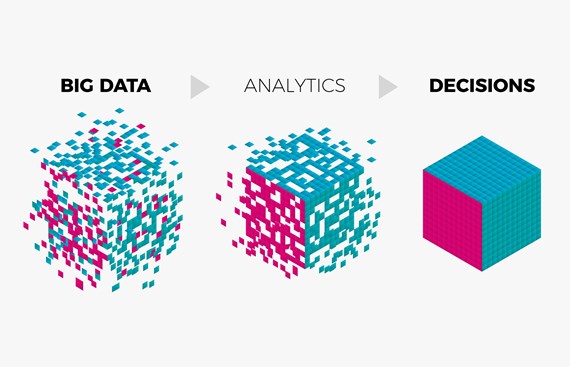
Demystifying data to provide better public services
The three data landscape layers to progress your data journey from collection to insight and action.
14 February 2023
By 2025, the world will produce over 180 zettabytes of data (one zettabyte is equal to one billion terabytes) and between 2010 and 2020 data interactions went up by 5000%!
As more data is created and as more of our daily activities are conducted in the digital sphere, organisations will need to ensure they have a robust solution to keep up with the inevitable rise in data prevalence.
The application of data in business is not a new concept, however, what has changed is how data analytics is utilised and the ability to capture vast amounts of data. Today, the sheer volume of data available requires organisations to take a different approach to how they use data for their benefit and to aid in decision making.
The current abundance of data and governance legislation now requires organisations to adopt a more strategic approach to what data they are collecting and how they are doing this. It is also important to consider the longer-term use of data, thinking about retention, review, and disposal of the data. The increased volume and access to data means that many more organisations are looking to leverage it to optimise processes and increase confidence in decision making.
What’s more, the advent of more powerful Artificial Intelligence (AI) has created more possibilities and opportunities to analyse large volumes of data that can be applied to decision making and align with business outcomes.
Collection of data is not limited to private-sector organisations, it is also an invaluable asset to government departments, especially as citizens are living and conducting their life increasingly through the digital sphere. For government departments, the use of data is essential to understand how these citizens interact with their services.
For example, for government departments such as the Cabinet Office or the Home Office, how they utilise and apply data could be helpful to make services more efficient and modernise legacy systems. Additionally, these departments could use data to understand how citizens use current services, then consequently use insights from this data to improve a service or make it more suitable.
Although having a data driven approach can make services more efficient, for government departments especially, this must be inclusive for all citizens and not leave those behind who are not digitally connected. Therefore, there is also a need to be careful and consider this approach from an ethical standpoint (including regulations such as GDPR) and ensure that it is equal and inclusive for all citizens.
In order to help us de-mystify the data analytics landscape, we will outline the three ‘layers’ of data;

Each of these layers feeds off each other, similar to the portfolio management approach of projects, programmes and portfolios. These three layers aim to provide guidance to focus on what data is important, how to leverage this data and then finally the strategy to utilise it to drive a business forward as well as take advantage of the data opportunities presented.
In a world where data is seemingly everywhere but critical insights are hard to find; this paper provides a high-level overview of these steps and is intended to invoke thought on how you can progress your data journey to insight and action.
This initial layer within the data landscape provides the foundation for data-driven evolution and transformation of an organisation. With the rise of social media, technology and everyone living their life through the digital world, it has become easier and more accessible for organisations to directly reach their users and customers, understand who they are and gain a more accurate insight on what they want and how they want to interact digitally.
One of the direct benefits of this is that organisations can see their return on investment and measure other success metrics such as customer satisfaction. In addition to user and customer data, organisations are increasingly digitising their business processes, meaning that transactional data from areas such as Finance, Production, Sales & Marketing, HR, Commercial, etc is routinely collected and stored across the organisation.
As organisations are collecting more and more data on their users, customers and internal processes, learning more about their target market or target audience and investigating the types of responses that resonate best, they subsequently need other practices in place to manage this.
Practices such as security and privacy to protect this data, having a team to clean, integrate and analyse the data, making it actionable and insightful for the other layers. After all, it is not the raw data itself that leads to greater efficiency and effectiveness; that is only achieved when data is tied to its operational context and integrated with other related data to provide useful insights and information.
Once an organisation has a greater understanding of their users, customers and internal processes they can gain a better understanding of how their own business is operating in relation to their purpose and objectives. Data will evolve from a niche subsidiary to taking a more holistic role within organisational decisions.
Without first understanding the users, customer and business processes through data collection and implementing changes internally to have the correct data structures in place, it subsequently becomes more difficult to automate or make certain processes more efficient without having the data behind it.
To automate processes or implement AI solutions, having the transactional data is imperative for the AI to learn from and identify patterns. As technology advances and use of Artificial Intelligence/Machine Learning becomes more prevalent, it will reduce effort spent on time-consuming, repetitive and mundane tasks and allow team members to focus on what humans do best; acting on data insights and being creative.
Additionally, it is this automation that makes the processing of much greater volumes of data a possibility. Having a strong data governance approach and the right structures in place from the start is imperative to ensure the quality of the data put into the system equates to quality data insight outputs. This would also futureproof the business to ensure it can keep up with the changing pace of technology.
With data driving and optimising operations, organisations can implement functions to help transform the organisation by fundamentally examining and challenging the core operating and business models in relation to strategic drivers such as competitors, politics, technology, environmental and legislative change (the traditional PESTL categories).
This transition from Layer 2 to Layer 3 should not be underestimated, it is a key step that requires the organisation to identify the types of data and insights required, using strategy, organisational and business analysis, portfolio and benefits management. Being effective at this layer would mean using the transactional and operational data and associated insights to assess what capabilities the organisation has and how best to transform these in the future to achieve a given strategy whilst fully exploiting digital and data services enabled by data services teams.
The relationship between data landscape modernisation, data transformation and data security are interdependent; as one aspect is developed, the other areas need to be equally progressed. For example, increasing data transformation without suitable security and governance could lead to greater vulnerability and risks undermining the original intent. Taking a holistic approach is key to ensure a balanced and benefit-focused strategic transformation process.

Data will continue to increasingly proliferate every part of business, organisational and personal worlds; the layered approach and recognition helps organisation to categorise and utilise the information available to them.
In order to thrive in the Fourth industrial revolution, gathering live and actionable insights from data is crucial. However, the process of generating the required insights from the complex myriad of transactional data sets requires a range of skills and expertise.
As the volume of data collected increases, storing it securely, protecting privacy and being able trust and translate it to ensure quality and trustworthy results is vital.
If you are struggling to gain insight from your data or not sure where to start to make your data work harder for your organisation, BMT’s data scientists, management consultants and cyber security consultants can help get you started on the journey.

Shauni is a consultant based at BMT’s Plymouth Office. She joined BMT in 2021 and has prior experience working in media, using data and insight to define messages and target audiences.
Within BMT, Shauni has worked in various areas across the business including Planning & Capability, Training Consultancy Services and a Project Management Office role in the Metropolitan Police.

Kathryn Walker
Coaching is a proven tool to support change leaders and their teams. The greatest impact and success has been achieved in transformation programmes, where structural and programmatic approaches are supported by attention to the cultural and behavioural aspects of change.

Will Roberts
At BMT, we believe simulation is a critical enabler in overcoming these hurdles—de-risking development, accelerating innovation, and building confidence across the entire lifecycle of autonomous systems.

N/A
Get ready to dive deep into maritime autonomy as we bring you technical experts, insightful opinions, and unmissable discussions.

Dr Thomas Beard
Episode 3 of IMarEST’s Ship Energy & Environment podcast series, addressed the ‘Realities and Challenges of Alternative Marine Fuels. Dr Thomas Beard, Clean Shipping Lead explores the practical side of the 'big four' alternative fuels.